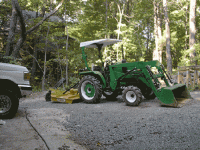SevenCorners
Silver Member
All Just got a new 224-LT today, she is really a nice tractor. It came with a FEL and 5'BH. I spent the afternoon learning how to use the BH on my mountainous land. It is a little spooky trying to go sideways I took it very easy and slow. I didn't mow anything I was not comfortable doing. It might have been a mistake getting the BH, I have a DR Field & Brush Mower that beats the hell out of me but I have never tipped it.
After reading several posts I turned the front wheels around to gain a couple of inches. Does anyone know exactly how many? I am planning on tackling the rears tomorrow, is it the same procedure as the fronts? I have weights on the rear, will they have to come off? How many inches will I gain from this? Also does anyone have any experience filling their tires? What material did you use? Water? Would you also give me the procedure for do this?
Thanks
Gavin in Charlottesville, VA
After reading several posts I turned the front wheels around to gain a couple of inches. Does anyone know exactly how many? I am planning on tackling the rears tomorrow, is it the same procedure as the fronts? I have weights on the rear, will they have to come off? How many inches will I gain from this? Also does anyone have any experience filling their tires? What material did you use? Water? Would you also give me the procedure for do this?
Thanks
Gavin in Charlottesville, VA
